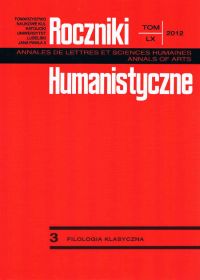The Ideal virgo-martyr in Prudentius’ Passio Agnetis
Abstract
In this essay the author juxtaposes two late fourth-century versions of the legend of the virgin martyr Agnes. According to the first one, presented by Damase and Ambrose, Agnes dies in the flames of fire. Prudentius introduces new details which were credited to the generation after Ambrose: the exposure in a place of ill repute, the miraculous preservation of her purity, and finally, the death by sword. Prudentius, in his poem, which is much longer than the Ambrosian hymn, adjusted a lot of motifs of virgin martyrdom to a different form of literary expression. In the course of the analysis of Prudentius’ poem there can be extracted the following motifs: the saint’s name, the age, the strength, the patience and perseverance in suffering, the refutation of pagan gods, the defence of virginity, the double crown as a prize for saving chastity and martyrdom, the mystic marriage—Agnes as a bride of Christ, the patron saint, the miracles through the intercession of the saint.
The poet’s hymn has become paradigmatic. It provided the inspiration for his successive writers, sometimes modifying or adding to the individual threads.
So intense, throughout the history, the use of themes contained in the hymn XIV provides not only a recognition, which was given to its author, but also the wealth of spiritual experiences learned from reading the text. To some extent, the motifs of virgin martyrdom described in this essay evaluate and order the idea of the hymn, which is based on quite uncertain source material. The use of popular motifs makes Prudentius’ hymn of the model for the work of its kind in early Christian literature.
References
Banterle G.: Introduzione, w: Opera Omnia di Sant’ Ambrogio, [vol. 22] Inni, iscrizioni, frammenti, Milano–Roma 1994, s. 11-18.
Bartelink G.J.M.: Sur les allusions aux noms propres chez les auters Grecs chrétiens, „Vigiliae Christianae” 15 (1961), s. 32-39.
Baslez M.F.: Prześladowania w starożytności. Ofiary. Bohaterowie. Męczennicy, przeł. E. Łukaszyk, Kraków 2009.
Den Boeft J., Bremmer J.: Review: Notiunculae Martyrologicae IV, „Vigiliae Christianae” 45 (1991) nr 2, s. 105-122.
Burrus V.: Reading Agnes: the rhetoric of gender in Ambrose et Prudentius, „Journal of Early Christian Studies” 3 (1995), s. 25-46.
Cytowska M., Szelest H.: Literatura rzymska. Okres cesarstwa. Autorzy chrześcijańscy, Warszawa 1994.
Diskant Muir C.: St Agnes of Rome as a Bride of Christ: A Northern European Phenomenon, c. 1450-1520, „Simiolus: Netherlands Quarterly for the History of Art” 31 (2004- 2005), nr 3, s. 135-155.
Fontaine J.: Le femme dans la poésie de Prudence, „Revue des études latines” 47bis (1970), s. 55-83 (Zbiór s. 415-443).
Franchi de’ Cavalieri P.: S. Agnese nella tradizione e nella legenda, „Römische Quartalschrift für christliche Alterthumskunde und für Kirchengeschichte”. Supplementheft 10 (1899), s. 1-67.
Fux P.Y.: Les sept passions de Prudence, Fribourg 2003 (Paradosis 46).
Gacia T.: Analiza hymnu „Agnes beatae virginis” św. Ambrożego, „Vox Patrum” 19 (1999), t. 36-37, s. 259-270.
Messenger R.E.: The Legend of St. Agnes in Early Latin Hymns, „The Classical Weekly” 37 (1943) nr 7, s. 75.
Nehring P.: Topika wczesnych łacińskich żywotów świętych (od Vita Antonii do Vita Augustini), Toruń 1999.
Nehring P.: Uwagi o czasowej strukturze najwcześniejszych łacińskich żywotów świętych, w: Chrześcijaństwo u schyłku starożytności. Studia źródłoznawcze, red. T. Derda, E. Wipszycka, t. 2, Kraków 1999, s. 109-127.
Nehring P.: Najwcześniejsza chrześcijańska opozycja wobec dziewictwa w świetle De virginitate V-VII św. Ambrożego, w: Chrześcijaństwo u schyłku starożytności. Studia źródłoznawcze, red. T. Derda, E. Wipszycka, t. 5, Kraków 2004, s. 197-217.
Raby F.J.E.: A History of Christian-Latin Poetry. From the Beginnings to the Close of the Middle Ages, Oxford, 1953.
Radoński K.: Święci i błogosławieni Kościoła Katolickiego. Encyklopedia Hagiograficzna, Warszawa–Poznań–Lublin 1947.
Riposati B.: La struttura degli inni alle tre vergini martiri del Peristephanon di Prudenzio (III, IV 109-144, XIV), w: Paradoxos Politeia, FS G. Lazzati, Milano 1979, s. 25-41.
Ruggiero F.: Szaleństwo chrześcijan. Poganie wobec chrześcijaństwa w pierwszych pięciu wiekach, tł. E. Łukaszyk, Kraków 2007.
Stabryła S.: The concept of martyrdom in Prudentius’ Peristephanon, „Analecta Cracoviensia” 30-31 (1999), s. 561-570.
Stabryła S.: Death for Chist as Victory in the light of Prudentius’ Peristephanon, „Analecta Cracoviensia” 33 (2001), s. 675-682.
Starowieyski M.: Wstęp, w: Aureliusz Prudencjusz Klemens, Wieńce Męczeńskie, przeł. M. Brożek i inni tłumacze, Kraków 2006.
The old French lives of Saint Agnes and other vernacular versions of the middle ages, ed. J. Denomy, Cambridge, Mass. 1938.
Walpole S.: Early Latin Hymns, Cambridge 1922, s. 69-71.
Wiśniewski R.: Cuda i świętość, w: Chrześcijaństwo u schyłku starożytności. Studia źródłoznawcze, red. T. Derda, E. Wipszycka, [t. 1], Warszawa 1997, s. 281-299.
Wipszycka E.: Kościół w świecie późnego antyku, Warszawa 2006.
Copyright (c) 2012 Roczniki Humanistyczne

This work is licensed under a Creative Commons Attribution-NonCommercial-NoDerivatives 4.0 International License.





